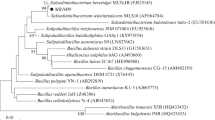Summary
The inhibition of Clostridium thermocellum strains by acetate and other organic acids (propionate, butyrate) can be explained by a model based on the chemiosmotic theory and uncoupler action. It is proposed that the charged permeant species in the process of anion exclusion is the dimer HA 2- . Evidence for this mechanisms is provided by 31P-NMR studies of whole cells and cell extracts.
Similar content being viewed by others
Abbreviations
- CM4-Cb:
-
CM4-cellobiose
- EPC50 :
-
equipotency concentration
- P m :
-
bilayer partition coefficient
- ka:
-
acid dissociation constant
References
Diamond JM, Katz Y (1974) Interpretation of nonelectrolytic partition coefficients between dimyristoyl lecithin and water. J Membr Biol 17:121–154
Finean JB, Coleman R, Mitchell RH (1978) “Membranes and Their Cellular Functions”, Halsted Press, John Wiley and Sons, New York
Foster M, McLaughlin S (1974) Complexes between uncouplers of oxidative phosphorylation. J Membr Biol 17:155–180
Freese E (1978) Mechanism of growth inhibition by lipophilic acids. In: JJ Kabara (ed), “Symposium on the Pharmacological Effect of Lipids”, American Oil Chemists' Society, Illinois
Freese E, Sheu CW, Galliersi E (1973) Function of lipophilic acids as microbial food additives. Nature 241:321–325
Ginsburg E, Solomon D, Sreevalson T, Freese E (1973) Growth inhibition and morphological changes caused by lipophilic acids in mammalian cells. Proc Nat Acad Sci USA 70:2457–2461
Herrero AA, Gomez RF (1980) Development of ethanol tolerance in Clostridium thermocellum: effect of growth temperature. Appl Environ Microbiol 40:571–577
Herrero AA (1981) “The Physiology of Clostridium thermocellum. The Toxicity of Its Fermentation Products in Relation to the Energy Metabolism”, Ph. D. Thesis, Massachusetts Institute of Technology, Cambridge, MA
Herrero AA, Gomez RF (1981) Inhibition of Clostridium thermocellum by fermentation products and related compounds in “Advances in Biotechnology”, Vol. II, Moo-Young and CW Robinson (eds), Pergamon Press, New York, pp 213–218
Herrero AA, Gomez RF, Roberts MF (1982) Ethanol-induced changes in the membrane lipid composition of Clostridium thermocellum. Biochim Biophys Acta 693:195–204
Herrero AA, Gomez RF, Roberts MF (1985) 31P-NMR studies of Clostridium thermocellum: mechanism of end product inhibition by ethanol J Biol Chem (in press)
Jain MK, Wagner RC (1980) “Introduction to Biological Membranes”, John Wiley and Sons, New York
Jain MK, Wu NM (1977) Effect of small molecules on dipalmitoyl lecithin liposomal bilayer. III. Phase transition in lipid bilayer. J Membr Biol 34:157–201
Jordan PC, Stark G (1979) Kinetics of transport of hydrophobic ions through lipid membranes including diffusion polarization in the aqueous phase. Biophys Chem 10:273–287
Kantor HL, Prestegard JH (1975) Growth inhibition and morphological changes caused by lipophilic acids in mammalian cells. Biochemistry 14:1790–1795
LeBlank OH (1971) The effects of uncouplers of oxidative phosphorylation on lipid bilayer membranes: carbonylcyanide m-chlorophenylhydrazone. J Membr Biol 4:227–239
Leo A, Hansch C, Elkins D (1971) Partition coefficients and their uses. Chem Rev 71:525–616
Maggio B, Lucy JA (1975) Studies on mixed monolayers of phospholipids and fusogenic lipids. Biochem J 149:597–608
Mitchell P (1974) A chemiosmotic molecular mechanism for proton translocating ATPase. FEBS Lett 43:189–194
Navon G, Shulman RG, Yamane T, Eccleshall TR, Lam K-B, Baronofsky JJ, Marmur J (1979) Phosphorus-31 Nuclear Magnetic Resonance Studies of Wild-Type and Glycolytic Pathway Mutants of Saccharomyces cerevisiae. Biochemistry 18:4487–4499
Racker E (1976) “A New Look at Mechanisms in Bioenergetics”, Academic Press, Inc., New York
Sheu CW, Salomon D, Simmons JL, Sreevelsan T, Freese E (1975) Inhibitory effects of lipophilic acids and related compounds on bacteria and mammalian cells. Antimicrob Agents Chemother 7:349–363
Sinskey AJ (1980) Mode of action and effective application. In: RH Tilbury (ed) Developments in Food Preservatives, Applied Science Pub. Ltd., London
Thauer RK, Jungermann K, Decker K (1977) Energy conservation in chemotrophic anaerobic bacteria. Bacteriol Rev 41:100–180
Tinsley IJ (1979) “Chemical Concepts in Pollutant Behavior”, John Wiley and Sons, New York
Ugurbil K, Rottenberg H, Glynn P, Shulman RG (1978) 31P nuclear magnetic resonance studies of bioenergetics and glycolysis in anaerobic Escherichia coli cells. Proc Natl Acad Sci USA 75:2244–2248
Weast RC (1975) “Handbook of Chemistry and Physics”, 5th Edition, The CRC Press, Cleveland, Ohio
Weimer PJ, Zeikus JG (1977) Fermentation of cellulose and cellobiose by Clostridium thermocellum in the absence and presence of Methanobacterium thermoautotrophicum. Appl Environ Microbiol 33:289–297
Author information
Authors and Affiliations
Rights and permissions
About this article
Cite this article
Herrero, A.A., Gomez, R.F., Snedecor, B. et al. Growth inhibition of Clostridium thermocellum by carboxylic acids: A mechanism based on uncoupling by weak acids. Appl Microbiol Biotechnol 22, 53–62 (1985). https://doi.org/10.1007/BF00252157
Received:
Issue Date:
DOI: https://doi.org/10.1007/BF00252157




